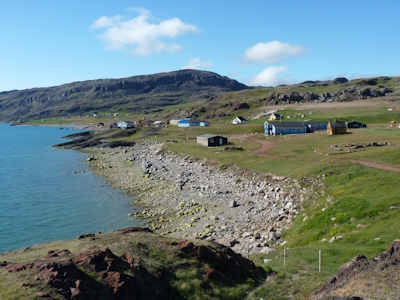Kujataa

Kujataa Greenland: Norse and Inuit Farming at the Edge of the Ice Cap represents farming and marine hunting cultures adapted to life in the Arctic.
The cultural landscape has features such as archaeological sites, agricultural lands and sheep farms. They include elements belonging to the Norse Greenlandic culture, the first emigrants from Europe to settle here and introduce farming, and to the Thule Inuit culture.
Community Perspective: both reviewers so far described a visit to the “beefed up” former Norse settlements Bratthalid and Gardar, located not far from the international airport of Narsarsuaq.

Map of Kujataa
Load mapCommunity Reviews
Thomas Buechler
Erik the Red who came all the way from Iceland to the Southwest Greenlandic fjords to find greener pastures, and must have found in here in Bratthlid (Qassiarsuk), so he called the lands Greenland in a good marketing move for other Viking farmers to follow him. In the year 985, it became the first Norse farm here. His son, Leif the Lucky, discovered the North American shores from here in the years to come. Also the "law speaker" resided here in Bratthlid. The archaeological area can be freely visited, and it takes a couple of hours to see the remains of farm houses, storehouses, and a small turf and wood church what is believed to be the remains of Thjodhild's (wife of Erik the Red) original church mentioned in the Icelandic Saga. It was only in 1126 that the Greenlandic Norse were given their own bishop, but he resided in Gardar in the Eastern Settlements. Present day the village is called Igaliku. His church was cross shaped, and even had a bell tower. All bishops were foreigners, and the last bishop who resided at Gardar has died in 1378. It is possible to rent boats between Bratthlid and Igaliku (or a place on the Tunulliarfik Fjord, then on foot). But during our time here, it was impossible due to strong winds and lots of icebergs on the fjord). We were lucky and it was not clear up to the last minute that we could cross from Narsarsuaq (location of airport with flights to Nuuk, and in summer charter flights to Copenhagen) to Qassiarsuk where we stayed at Leif Eriksson Hostel that is run by an energetic crew of volunteers from Mallorca and offers bed&breakfast&dinner at 90 € pP. Seasonal opening only, in fact we were one of the last guests, they close by the end of September. The flight to Nuuk does not happen every day, so plan well ahead, and leave some open days in case it is cancelled at short notice due to bad weather. Flights in Greenland are expensive, but still cheaper than the luxury cruise ships.
Solivagant

The Norse settlement of Greenland and the North American mainland remains one of history’s great “what ifs” so it was interesting to visit Bratthalid and Gardar (on the same day) during a trip in southern Greenland in 2010 and discover more about this historical cul de sac.
All 3 T list sites are situated within the Norse “Eastern Settlement” – which, confusingly, was located on Greenland’s SW coast. A “Western Settlement” was further North – and a bit further West! At their greatest extent the population across both was probably only around 4000 and possibly as low as 2000. The first people arrived from Iceland in 980. The Western Settlement had been abandoned by around 1300 and the last recorded occupation of the Eastern Settlement was in 1408 – though it may have struggled on for some years thereafter. Indeed when Denmark (which merged with Norway in 1380) re-invigorated its interest in Greenland in 1721 in the form of the missionary Hans Egede, he actually hoped to find some Norse settlements and was concerned that they would still be Catholic, having “missed out” on the Protestant Reformation!! Although the settlements adopted agriculture and animal husbandry they apparently never achieved (nor sought) any degree of autonomy, cultural or physical, from Iceland/Norway, being part of a trading system whereby walrus/narwhal ivory and sealskins etc were exchanged for European necessities. Throughout these settlement years regular visits were probably being paid to the coasts of mainland N America parts of which were named as Helluland, Markland and Vinland, - indeed the Sagas indicate that the first one could have been as as early as 1000. However only the famed, UNESCO inscribed, “Anse aux Meadows” has been specifically identified as a Norse settlement – and it may have been occupied for as little as 10 years and may or may not have been the location of Leif Eriksson’s “Vinland”. In contrast the Eastern settlement was occupied for almost as long as the Americas proper have been settled by Europeans since 1492!!
Gardar, located in the modern settlement of Igaliku, was the “capital” of these settlements and, as the seat of the Bishop of Greenland, contained his “Cathedral”!! I quite like the idea of the Pope in Rome appointing, over several centuries, bishops to a church in the Americas whilst not realizing what possibilities existed a relatively short distance away! The remains of this structure are clearly visible (see photo) together with a (modern) tombstone covering the exhumed grave of Olaf who was Bishop from 1246-1280. Photos and a description of the excavation can be seen in the excellent little National Museum in Nuuk (which also contains the incomparable Qilakitsoq mummies).
Bratthalid is situated to the north of Gardar within the modern settlement of Qassiarsuk and is something of a “tourist centre” (in Greenlandic terms anyway!) with a youth hostel, a souvenir shop/cafe and one of Greenland’s 2 international airports (though Nuuk also has summer flights to Iceland) on the other side of the iceberg dotted fjord. It was the site where Eric the Red (the first "settler")had his "estate" and a bronze statue of his son Leif Eriksson, erected in 2000 to commemorate the (approximate!) 1000th anniversary of his voyage to the American mainland from this spot, stands atop a nearby hill facing west. Local boat services enable you to explore the area – and reach Gardar. Turf/Stone outlines of various buildings which are only visible by excavation have been created over the hidden remains and include what is said to have been the very first church in the Americas. To beef up these limited remains a replica of “Þjóðhildarkirkja” has been built, together with a Norse Long house. A local (Icelandic) teacher dresses up as Norse woman and recounts (in English and at length!) the Sagas! Unfortunately I haven’t (yet!) been to Anse aux Meadows but searches on the Web seem to indicate that it too “suffers” from not actually having much authentic on show and also has to make do with reconstructions of long houses etc.
But the T list entry for these sites describes them as a “Norse-Eskimo Cultural Landscape” (surely that non-PC word “Eskimo” will have to be removed!!). This indicates that the site is being marketed as more than just a few Norse ruins – rather it offers “the opportunity of tracing the evolution of the Eskimo/Greenlandic culture from the 15th and 16th centuries into the 20th century when other kinds of employment than hunting made new forms of settlement necessary”. So the description includes some Thule culture remains and emphasizes the later “fusion culture” which constitutes modern Greenland – “the settlement of Igaliku, where a Norwegian, Anders Olsen, along with his Eskimo wife Tuperna, settled as a farmer at the end of the 18th century. This marked the founding here of a Greenland farming dynasty.” The Thule culture only arrived in Greenland from Arctic Canada around the 13th century and took time to move south and eventually replace the Norse – such that the extent and nature of contacts (if any) between the Norse and Thule during their period of joint occupation is still a matter of debate. We saw Thule graves outside Igualku which had no relationship whatsoever with the (earlier!!!) Christian site.
Unless you are a “Norse history” specialist the Norse remains of Greenland are only going to be of curiosity interest since there is, in all honesty, not a great deal to see and, with Anse aux Meadows having got in first, there would seem little chance of these Greenlandic Norse remains being inscribed on their own. However, if and when Greenland gets full independence, it may well have a stronger argument for a cultural site and this cultural landscape aspect might be enough to give it a chance given UNESCO’s desire to be “inclusive”. We certainly enjoyed the mix of interests – having walked past flower and grass filled meadows I can certainly understand how Greenland got its name from this area at least!
Susan Dietrich
I visited Brattahlid and Garder in 1974. It was incredible to discover actual ruins from the time of Erik the Red and at Garder his daughter Freydis still in existance. Amazing to think they have stood the test of time so well and one can still vividly imagine what is was like to settle there over 1,000 years ago. I never will forget the experience. Staying at Blue West One, hiking to the inland glacier, traveling down the fjord by boat, which I recall was named the Good Little Knud after Knud Rasmussen,to Narsaq, everything was marvelous. So marvelous in fact, that I later wrote a novel about all the Erikssons from the point of view of Gudrid Thorbjornsdatter yet to be published. If you like I will send you a copy. Anyway I am glad these places have become listed on the World Heritage List, along with L'anse aux Meadows in Newfoundland, another great place I have visited.
Site Info
- Full Name
- Kujataa Greenland: Norse and Inuit Farming at the Edge of the Ice Cap
- Unesco ID
- 1536
- Country
- Denmark
- Inscribed
- 2017
- Type
- Cultural
- Criteria
-
5
- Categories
- Cultural Landscape - Continuing
- Link
- By ID
Site History
2017 Advisory Body overruled
ICOMOS advised Referral
2017 Inscribed
2015 Revision
Name changed from "Church ruin at Hvalsø, episcopal residence at Gardar, and Brattahlid (A Norse/Eskimo cultural landscape)"
Site Links
Unesco Website
Official Website
Connections
The site has 15 connections
Art and Architecture
Ecology
Geography
Human Activity
Religion and Belief
Timeline
Trivia
Visiting conditions
WHS Names
WHS on Other Lists
World Heritage Process
Visitors
15 Community Members have visited.
The Plaque